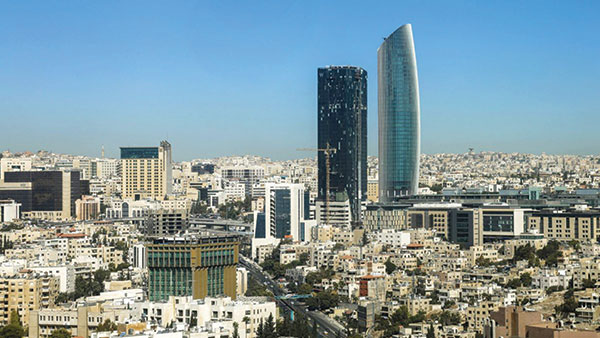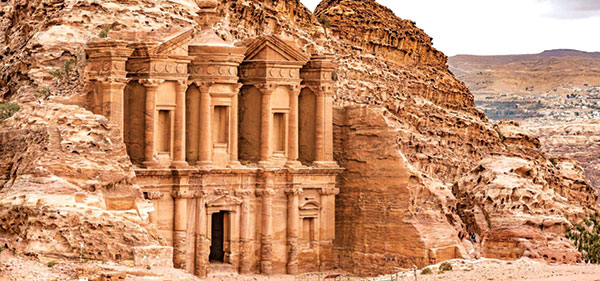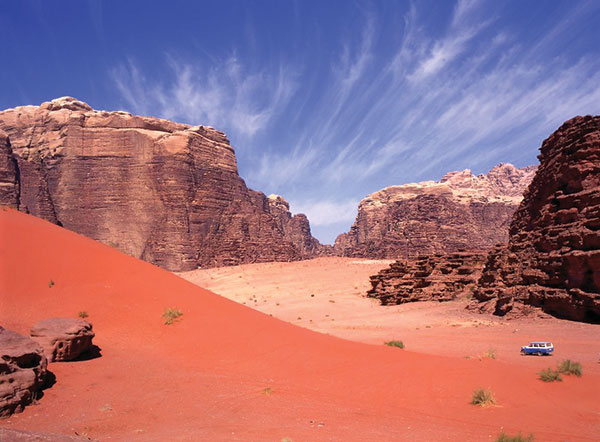Jordan: Suffused with history and biblical lore
The epicentre of the world’s three great monotheistic religions (Judaism, Christianity and Islam), Jordan is a tiny desert kingdom wrapped in history – Indira Gidwani
 Born out of the ruins of World War 1, the Hashemite Kingdom of Jordan (HKJ, pop: 10 million) sited on the east bank of the biblically famous River Jordan, owes its origin to one of the oldest civilizations of the world. Once an important commercial centre of the Roman Empire and epicentre of the world’s three great monotheistic religions (Judaism, Christianity and Islam), Jordan is a tiny desert kingdom wrapped in history. This region has always been on the fringes rather than centre of empires, but its strategic position ensured it was always influenced by early civilizations. Egyptians, Assyrians, Babylonians, Hittites, Greeks, Romans, Arabs, Turks and Crusaders — all traded, built cities and fought wars here leaving behind rich cultural imprints.
Born out of the ruins of World War 1, the Hashemite Kingdom of Jordan (HKJ, pop: 10 million) sited on the east bank of the biblically famous River Jordan, owes its origin to one of the oldest civilizations of the world. Once an important commercial centre of the Roman Empire and epicentre of the world’s three great monotheistic religions (Judaism, Christianity and Islam), Jordan is a tiny desert kingdom wrapped in history. This region has always been on the fringes rather than centre of empires, but its strategic position ensured it was always influenced by early civilizations. Egyptians, Assyrians, Babylonians, Hittites, Greeks, Romans, Arabs, Turks and Crusaders — all traded, built cities and fought wars here leaving behind rich cultural imprints.
During World War I, the British — and particularly the legendary T.E. Lawrence — unified disparate Bedouin tribes into the Arab Legion. After the success of the Great Arab Revolt against the Turks during World War I, HKJ was established by King Abdullah I, with Amman as its capital in 1921. In a 30-year reign during which he consolidated his rule and unified the kingdom, King Abdullah I was succeeded in 1953 by his grandson the late King Hussein who ruled for 46 years until his death in 1999, when his son King Abdullah II assumed the throne. Since then under the rule of Sandhurst-educated Abdullah II, Jordan has emerged as an oasis of liberal democratic (Jordan has its own Parliament with a loyal opposition) rule in the politically troubled Middle East.
Indeed, over the past decade despite — or perhaps because of its more than two million-strong Palestinian refugee population — Jordan has morphed into a safe and stable nation averaging GDP growth of 3.5 percent per year. This small country currently boasts a per capita income of $9,110, 98 percent literacy, and 20 private and ten public universities and a remarkably modernised and educated Bedouin population.
Amman
 One of the world’s oldest continuously inhabited cities, Jordan’s capital Amman (pop: 4.2 million) is a classic convergence of old and new, ideally sited on seven hills between the desert and the fertile Jordan Valley. In the commercial heart of the city, ultra-modern buildings, hotels, restaurants, art galleries and boutiques comfortably co-exist with traditional coffee shops, artisans’ workshops and folk sights and sounds.
One of the world’s oldest continuously inhabited cities, Jordan’s capital Amman (pop: 4.2 million) is a classic convergence of old and new, ideally sited on seven hills between the desert and the fertile Jordan Valley. In the commercial heart of the city, ultra-modern buildings, hotels, restaurants, art galleries and boutiques comfortably co-exist with traditional coffee shops, artisans’ workshops and folk sights and sounds.
Almost half the population of the HKJ lives in the greater Amman area. The city offers its visitors plenty of lively night life, with everything from cultural and theatrical events to traditional Arab entertainment, modern restaurants and clubs. Known in the Old Testament as Rabbath Ammon, the capital of the Ammonites circa 1,200 BC, in the 3rd century BC it was renamed Philadelphia after the eponymous Ptolemaic ruler (243-246 BC). In the Byzantine period (6th-7th century AD) Philadelphia was the seat of a bishop of the church of Rome when several churches were built.
Following the spread of Islam over the Arabian peninsula and its environs after 635 AD, the city reverted to its original Semitic name of Ammon or Amman. After the Great Arab Revolt following World War I when the Hashemite Kingdom of Jordan was established, Emir Abdullah I designated Amman as its capital in 1921. No more than a four-hour drive from anywhere in the country, Amman is also a perfect base for exploring this land suffused with history and biblical lore.
The Citadel is a good starting point to begin a tour of the archaeological sites of the city. It’s the site of ancient Rabbath Ammon and excavations here have revealed the ruins of a Temple of Hercules, an Ummayyad Palace and a Byzantine Church. Towering above Amman, it offers stunning views of the city. At the foot of the Citadel lies a 6,000-seat Roman theatre.
The next stop for visitors is the grand ruins of the Roman city of Jerash, 48 km north of Amman, and a must-see for history buffs. Set on a flower-covered hillside, Jerash is a well-preserved Roman town, where you can still see chariot marks on the bleached white paving stones of the marketplace. Situated on the crossroads of Damascus, Baghdad, Jerusalem and Amman, this fine Roman site boasts an unbroken chain of human occupation dating back more than 6,500 years. A walk through Jerash is a journey backwards into time.
The city’s golden age came under Roman rule (63-313 BC) and Jerash is acknowledged as one of the largest and best-preserved sites of Roman architecture outside Italy. Buried in desert sand for centuries before being excavated and restored over the past 70 years, Jerash reveals an excellent example of Roman urbanism in its paved and colonnaded streets, soaring hilltop temples, theatres, Hippo-drome, spacious public squares and plazas, baths, fountains and city walls guarded by towers and gates.
Petra
 A mere two-hour drive from Amman, the red sandstone city of Petra is a heady introduction to this country. A national treasure and Jordan’s greatest tourist attraction, Petra inspired John William Burgon’s famous sonnet “Match me such a marvel save in Eastern clime/ of rose-red city half as old as time.” Concealed among the barren mountains of the south and hidden from European eyes for 600 years, Petra was built 2,000 years ago by the Nabateans, an ancient civilisation which borrowed from the Egyptians, Greeks and Romans to build a mysterious stone city carved into the steep rocks of a valley.
A mere two-hour drive from Amman, the red sandstone city of Petra is a heady introduction to this country. A national treasure and Jordan’s greatest tourist attraction, Petra inspired John William Burgon’s famous sonnet “Match me such a marvel save in Eastern clime/ of rose-red city half as old as time.” Concealed among the barren mountains of the south and hidden from European eyes for 600 years, Petra was built 2,000 years ago by the Nabateans, an ancient civilisation which borrowed from the Egyptians, Greeks and Romans to build a mysterious stone city carved into the steep rocks of a valley.
Now a Unesco World Heritage Site, the tourists’ base of Petra is located in the town of Wadi Musa (‘Valley of Moses’), next to the entrance of the site. For exploring this awesome rock city, a one-day visit is the absolute minimum, although even a week’s sojourn will still leave many areas unexplored. There are miles to walk and if you prefer not to, hire a horse, a camel or horse-drawn carriage to take you from the imposing main entrance through the Siq, a high narrow gully carved into swirling pastel-coloured rocks. Paved by the Romans, the Siq was believed by the Nabateans to be a sacred passageway and they decorated its walls with altars and shrines. With its sheer walls towering above as you walk through narrow passages, you’ll be stunned by the sight of its rose-tinted walls and buildings.
The Siq twists, turns and narrows before finally revealing the shining façade of Petra’s most famous monument, the Treasury or Al-Khazneh, a dazzling Nabatean masterpiece which shines with a light of its own. Familiar as the site of the final sequence of the film Indiana Jones and the Last Crusade, this dramatic façade is only the first of Petra’s secrets.
Other notable attractions are a 3,000-seat amphitheatre of the early 1st century A.D, a palace tomb in the Roman style and Qarr al-Bint, the only free-standing building that survived in this ancient habitation. A climb of over 900 rock-cut stairs will bring you to a gigantic first century Al Deir Monastery — a huge façade carved into a rockface offering a view of the windswept plains around. Also take in the High Place of Sacrifice where Abraham offered to sacrifice his son Isaac to Jehovah.
Worthy of an experience is Petra by night — a magical world unspoilt, lit by the stars and 1,800 candles. The night-walk takes you from the Siq to the Treasury along a candle-lit path and to the haunting tunes of a Bedouin choir at the Treasury.
The residential accommodation available — 72 hotels — in Wadi Musa is excellent and includes budget and 5-star hotels.
Wadi Rum
 The great Arabist T.E. Lawrence (aka Lawrence of Arabia) described Wadi Rum as “vast, echoing and God-like’’. In fact, much of David Lean’s 1962 epic Lawrence of Arabia was filmed in Wadi Rum. A 90-minute drive from Petra transports visitors to this largest and most magnificent of Jordan’s landscapes, a stupendous untouched valley devoid of human habitation. Also known as The Valley of the Moon, this highly defensible narrow valley prompted Prince Faisal Bin Hussein and Lawrence to base their headquarters here during the Arab Revolt against the Ottomans in World War I, and their exploits are intrinsically woven into the history of its amazing landscape.
The great Arabist T.E. Lawrence (aka Lawrence of Arabia) described Wadi Rum as “vast, echoing and God-like’’. In fact, much of David Lean’s 1962 epic Lawrence of Arabia was filmed in Wadi Rum. A 90-minute drive from Petra transports visitors to this largest and most magnificent of Jordan’s landscapes, a stupendous untouched valley devoid of human habitation. Also known as The Valley of the Moon, this highly defensible narrow valley prompted Prince Faisal Bin Hussein and Lawrence to base their headquarters here during the Arab Revolt against the Ottomans in World War I, and their exploits are intrinsically woven into the history of its amazing landscape.
There are several options for exploring Wadi Rum. Visitors can hire a jeep with a guide or alternatively, they can hire a camel and bedouin guide.
We opted for a jeep safari skidding on rolling sands through the vast wilderness. The ride was awesome, with a maze of sandstone jabals (escarpments) rising at right angles from the valley floor to heights of upto 1,750 metres. They tower over a small bedouin village, which includes the Desert Patrol Fort (now a police station). The men of the Desert Police, dressed in khaki uniforms still ride camels and are a spectacle in themselves. In this sandy desert one can explore canyons and waterholes and stumble upon 4,000-year-old rock drawings among other spectacular treasures.
Recently there has been great interest to encourage desert tourism with paragliding, hiking and mountain climbing in Wadi Rum. There are bedouin-style campsites with all facilities. Bed and breakfast establishments are also available in Rum village.
Aqaba
 Greatly prized as Jordan’s window to the Red Sea, Aqaba is a refreshing contrast to the rose-coloured desert to the north. A mere one-hour’s drive from Wadi Rum, its sandy beaches and coral reefs are the most pristine of the Red Sea.
Greatly prized as Jordan’s window to the Red Sea, Aqaba is a refreshing contrast to the rose-coloured desert to the north. A mere one-hour’s drive from Wadi Rum, its sandy beaches and coral reefs are the most pristine of the Red Sea.
An Indigo-coloured deep sea lies just offshore in Aqaba, with a kaleidoscopic marine life beneath. Aqaba’s reef is thriving with variety in its coral and fish. There’s diving, swimming, fishing, snorkelling and sailing for recreation or glass-bottomed boats for those who prefer marine life at arm’s length. The Aqaba resort is especially appealing with a wide selection of swimming pools.
For those interested in more than sun and sand, there’s a mameluke fort at the end of the corniche, and situated on an island in the middle of the Gulf is the Castle of Saladin, the formidable adversary of Richard the Lionheart and Reynold de Chatillon. In 1916, Arab forces with T.E. Lawrence wrested the fort from the Ottomans in one of the most dramatic victories of the Arab revolt.
Inevitably, Jordan has a lot to offer pilgrims and religious tourists. The area opposite Jericho has been identified for nearly two millennia as the site of Jesus Christ’s baptism by John the Baptist, patron saint of Jordanian Christians. Stunning archaeological discoveries between the Jordan River and Tell al-Kharrar since 1996, have identified this area as the biblical ‘Bethany beyond the Jordan’, where St. John lived and preached before the baptism of Jesus.
Tell al-Kharrar, also known as Tell Mar Elias (St. Elijah Hill), is believed to be the site of Prophet Elijah’s ascent to heaven in a chariot of fire. Anjara is a town where Jesus Christ, his mother Mary and his disciples passed through and rested in a nearby cave now commemorated with a shrine to our Lady of the Mountain. Nearby is Mukawir, where Salome cast a spell over men in perpetuity, and was the hilltop stronghold of Herod the Great. Upon Herod’s death, his son Herod Antipas inhabited the fortress from where he ordered the beheading of John the Baptist. All these, including Mount Nebo and Madaba were designated by the Vatican as Millennium 2000 sacred sites when Pope John Paul visited Bethany beyond the Jordan and the holy land during his pilgrimage of March 2000.
The most revered holy site in Jordan is Mount Nebo, just an hour’s drive from Amman. This is where Prophet Moses was buried and atop the mountain, one can survey as Moses did, the vast panorama encompassing the Jordan River Valley, the Dead Sea, and the twinkling night lights of Jericho and Jerusalem. It remains a pilgrimage for Christians and Mount Nebo’s first church was built in the late 4th century to mark the site of Moses’ death. The Serpentine Cross which stands just outside the sanctuary is symbolic of the brass serpent taken by Moses into the desert, and the cross upon which Jesus was crucified. The Moses Memorial Church at Mt. Nebo displays a large number of striking mosaics.
Close to Mt. Nebo is Madaba ‘the City of Mosaics’. Among its chief attractions is the Greek Orthodox Church of St. George, which houses a wonderfully vivid, 6th century Byzantine mosaic map showing Jerusalem and other holy sites. Moreover, there are dozens of other mosaics from the 5th through the 7th centuries scattered throughout Madaba’s churches and homes. An extensive archaeological park and museum complex encompassing the remains of several Byzantine churches, including the outstanding mosaics of the Church of the Virgin and the Hyppolytus Hall, are exceptionally beautiful and should not be missed.
Dead sea
 The ideal way to round off a Jordan holiday is to drive down to the Dead Sea, 60 minutes from Amman. At 400 metres (1,312 ft) below sea level, the Dead Sea is one of the most spectacular natural and spiritual landscapes in the world and the lowest point on earth. This vast stretch of water receives a number of incoming rivers, including River Jordan. Once the waters reach the Dead Sea they are landlocked and have nowhere to go, so they evaporate, leaving behind a rich cocktail of salts and minerals that supply industry, agriculture and medicine with some of their finest products.
The ideal way to round off a Jordan holiday is to drive down to the Dead Sea, 60 minutes from Amman. At 400 metres (1,312 ft) below sea level, the Dead Sea is one of the most spectacular natural and spiritual landscapes in the world and the lowest point on earth. This vast stretch of water receives a number of incoming rivers, including River Jordan. Once the waters reach the Dead Sea they are landlocked and have nowhere to go, so they evaporate, leaving behind a rich cocktail of salts and minerals that supply industry, agriculture and medicine with some of their finest products.
Widely believed to be the site of five biblical cities — Sodom, Gomorrah, Admah, Zabolim and Zoar (Bela), in the Book of Genesis — God refers to the Jordan River Valley around the Dead Sea as the ‘Garden of the Lord’ and it’s believed to be the site of the Garden of Eden. Today its eastern shore has evolved into a religious and health and wellness tourism hub of the region. With much of the landscape virtually unchanged since ancient times, this is a favourite spot for a holiday drive.
Spend the day sunbathing, swimming or dining. Relax in the gently lapping waters and rest reassured that you won’t sink because of the heavy salt content of the Dead Sea! Treat yourself to a soothing massage or try the well-known healing powers of minerals from the sea’s muddy floor. For a more leisurely stay, spend the night at a comfortable hotel that overlooks the sea to the western bank.
Over and above all this history, geography and religion, what will linger in your memory after you return from this enchanting desert kingdom will be the bittersweet taste of cardamom coffee, the smell of a richly scented narglieh (water pipe), the intoxicating swirl of Arabic pop sliding out of an Amman doorway, and the deafening silence of the desert.
Jordan fast facts
Getting there: Royal Jordanian, the national carrier of Jordan, flies directly to Amman from Mumbai and four times a week from New Delhi. All the other Gulf airlines including Emirates, Kuwait Airways, Gulf Air, Etihad etc, flying from Indian metros offer connecting flights to Amman.
Currency: $1 = 0.71 JD (Jordanian Dinar)
Language: While Arabic is the official language in Jordan, English is widely spoken.
Best time to visit: October-May
Accommodation: There are plenty of hotels ranging from international chains like Grand Hyatt, Le Meridien, Amman Marriott Hotel, Four Seasons, Sheraton Amman Al Nabil, etc, to small budget and one-three star hotels. Room prices for five-star and four-star hotels range between Rs.11,000-15,000 per day. The suites range from Rs.15,000-24,000 per day. While in a three-star the prices are a modest Rs.3,000 upwards per day.

















Add comment